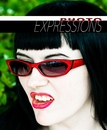
If
projects are the answer to being more creative, how do you come up with the idea ? I've been occasionally hung up on the thought that the project has to be grandiose and special - something that is going to change the world like Dorothea
Lange's FSA series or Ansel Adam's images that launched the National Parks program in the US. I know my projects aren't that important or interesting, so sometimes that stops me even wanting to start. But I don't think I should be comparing myself against those images that have been filtered down through history, so that only the great and good remains. Anyway, I doubt those were the first assignments those fine photographers had, either!
It strikes me that, as is common in many endeavors, that productivity is one of the main keys to being creative. Just get stuck in there and take the pictures. The theme, other than being something that really interests you, isn't so important, as long as it makes you take the pictures. Worrying that pictures I haven't yet taken, aren't good enough, is just another form of procrastination. If I don't take them, I can be certain they won't be good enough, that's for sure.
I've tried to pick a few project themes in the past and I have a couple that I've recently started. One thing I've noticed is that the more open ended and loosely defined the project is, the more trouble I have in making progress with it. That's for a couple of reasons. Firstly, without a clearly defined subject, it is sometimes even hard to know what is part of a project and what isn't. A loosely defined project like pattern or portraits is generic to the point of being meaningless. I've found more tightly defined scopes of subject or theme really helps me focus in. Another key is that the subject should be accessible. So choosing to shoot Tibetan monks might be an appealing idea, but not very accessible to let me shoot over and again. Texan cowboys might be a better idea (unless I lived in Tibet)
I've also found that a technical hook can pull the images together, either by using one camera format, or one lens, or keeping the post processing to a consistent style or colour palette. I have one series that is being shot all on a lensbaby. Another has the same post processing, lens and shooting style. The pictures hang together thematically and visually as a result. I've thought at times that this is a gimmick, but the more I look at other projects by other photographers, I can see this same concept used to link the images. When it doesn't happen, it can be jarring and the project looses cohesion.
The other key for me is to define an end point. While many people devote their lives to shooting a particular theme, returning time and again to the same subject, I think for now I need to know when I'm done. Perhaps more importantly, this lets me gauge where I am along the way and allow me to demonstrate progress to myself. It will also keep me on track - I can produce a shot list and just tick them off as they get done. I think that'll help make me move on. Shorter duration projects are also a part of this. For now, grand 5 year plans will just lead me nowhere. I'll be better off picking a project I can shoot in a weekend, or a month or 6 months and actually finishing it, rather than starting yet another long term, long range theme. Along with this, I've found it helpful to define an end product, so that I know what I'm shooting for. This might be a set of prints, or a pdf, or a book or a website - what the end product is doesn't really matter, but if I know where I'm going, then it can help guide the type of pictures I'm going to take.
 At this time of year many people decide to embark on a Picture a Day (PAD) or Picture a Week (PAW) projects, to kick start productivity or to try to learn a new area of photography. Often those dry up or become chores. I did a picture a week project in 2005, that produced some good images and kept me shooting, but none of the images have anything in common, other than they were all shot by me. There are some good and not so good pictures in there, but I waffled around different genres, which makes it next to impossible to really improve in any one area.
At this time of year many people decide to embark on a Picture a Day (PAD) or Picture a Week (PAW) projects, to kick start productivity or to try to learn a new area of photography. Often those dry up or become chores. I did a picture a week project in 2005, that produced some good images and kept me shooting, but none of the images have anything in common, other than they were all shot by me. There are some good and not so good pictures in there, but I waffled around different genres, which makes it next to impossible to really improve in any one area.















